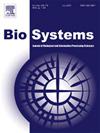Chemical oscillatory reactions with proteinoids
IF 1.9
4区 生物学
Q2 BIOLOGY
引用次数: 0
Abstract
This study aimed to investigate the potential of proteinoids to act as substrates for chemical oscillatory reactions. Proteinoids are thermally polymerized polymers of multiple amino acids, and their unique physicochemical properties make them suitable substrates in chemical vibration reactions. To this end, experiments were carried out using the Belousov–Zhabotinsky (BZ) and Briggs–Rauscher (BR) reactions as models, with the proteinoids acting as substrates and the resulting cyclic color changes and redox potential fluctuations being observed. The results demonstrated that specific proteinoids (PV, AEV and APV) exhibited oscillatory behavior in the BZ reaction, with PV exhibiting the highest degree of oscillation and activation energies similar to those of the conventional BZ reaction. In contrast, the BR reaction exhibited cyclic behavior exclusively when DCP was employed as a substrate, suggesting that the molecular structure of the proteinoid exerts a profound influence on its substrate properties. Notably, no oscillatory reactions were observed in the amino acid mixture utilized as a control experiment, underscoring the distinctive nature of proteinoids as unique macromolecules capable of triggering chemical oscillatory reactions. These findings indicate that proteinoids may serve as promising models for investigating the origin and early evolution of life. This research broadens the scope for exploring dynamic molecular systems using proteinoids, offering new avenues for research in life sciences and chemistry.
与类蛋白的化学振荡反应
本研究旨在探讨类蛋白作为化学振荡反应底物的潜力。类蛋白是由多种氨基酸热聚合而成的聚合物,其独特的物理化学性质使其成为化学振动反应的合适底物。为此,实验以Belousov-Zhabotinsky (BZ)和Briggs-Rauscher (BR)反应为模型,以类蛋白作为底物,观察其循环颜色变化和氧化还原电位波动。结果表明,特定的类蛋白(PV、AEV和APV)在BZ反应中表现出振荡行为,其中PV振荡程度最高,活化能与常规BZ反应相似。相比之下,当DCP作为底物时,BR反应仅表现出循环行为,这表明类蛋白的分子结构对其底物性质有深远的影响。值得注意的是,在作为对照实验的氨基酸混合物中没有观察到振荡反应,这强调了类蛋白作为能够触发化学振荡反应的独特大分子的独特性质。这些发现表明,类蛋白可以作为研究生命起源和早期进化的有希望的模型。本研究拓宽了利用类蛋白探索动态分子系统的范围,为生命科学和化学研究提供了新的途径。
本文章由计算机程序翻译,如有差异,请以英文原文为准。
求助全文
约1分钟内获得全文
求助全文
来源期刊

Biosystems
生物-生物学
CiteScore
3.70
自引率
18.80%
发文量
129
审稿时长
34 days
期刊介绍:
BioSystems encourages experimental, computational, and theoretical articles that link biology, evolutionary thinking, and the information processing sciences. The link areas form a circle that encompasses the fundamental nature of biological information processing, computational modeling of complex biological systems, evolutionary models of computation, the application of biological principles to the design of novel computing systems, and the use of biomolecular materials to synthesize artificial systems that capture essential principles of natural biological information processing.
 求助内容:
求助内容: 应助结果提醒方式:
应助结果提醒方式:


